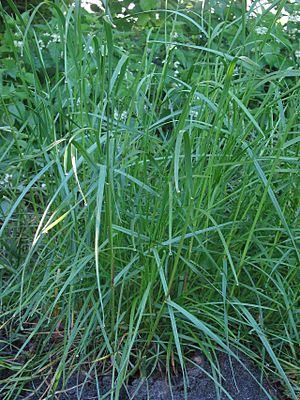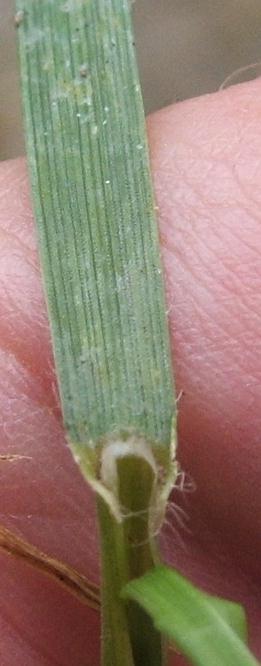Lolium perenne facts for kids
Quick facts for kids Lolium perenne |
|
|---|---|
 |
|
| Scientific classification | |
| Genus: |
Lolium
|
| Species: |
perenne
|
Lolium perenne, also known as perennial ryegrass, is a common type of grass. It belongs to the Poaceae family, which includes many grasses. This plant originally grew in Europe, Asia, and northern Africa. Today, you can find it growing all over the world because people have planted it in many places.
Contents
What Perennial Ryegrass Looks Like
Perennial ryegrass is a short grass that grows in clumps. It doesn't have hairs on its leaves or stems. The leaves are dark green and shiny on the bottom. On the top, they have clear parallel lines, like small veins. When the leaves are still buds, they are folded lengthwise. This makes them look flat.
At the bottom of each leaf blade, there's a very short part called a ligule. It can be hard to see. There are also small white parts called auricles that wrap around the stem. The bottom parts of the leaf stems are often a bit pink and smooth. The main stems of the plant can grow up to 90 centimeters (about 3 feet) tall.
The flowers of this grass grow on a single, unbranched stem. Small groups of flowers, called spikelets, grow on opposite sides of the stem. Each spikelet has one protective leaf, called a glume. It also has between four and 14 tiny flowers, called florets. Unlike some other ryegrasses, these florets do not have long bristles (awns). The parts that hold pollen, called anthers, are light yellow. This grass flowers from May to November.
Perennial ryegrass has many roots that spread out like a net. It has some thick main roots and many thinner side roots. These roots often work with tiny fungi in the soil. This helps the plant get nutrients.
Where Perennial Ryegrass Grows
Perennial ryegrass naturally grows in southern Europe, the Middle East, North Africa, and parts of central Asia. Farmers found it useful for feeding animals and for grazing. So, they took it with them when they moved to new places like North America, South Africa, and Australia.
This grass is also good for stopping soil from washing away. It can make the soil stronger. It's also used to create tough lawns and golf courses. Because it makes many seeds and grows easily, it has spread from farms. You can now see it along roads, paths, riverbanks, and even on sand dunes. In some countries where it was brought by people, it can grow so well that it takes over. This means it can compete with plants that naturally grow there.
How We Use Perennial Ryegrass
Perennial ryegrass is a very important plant for farms. It is often planted in fields where animals graze. It is also used as "forage," which means it's cut and fed to livestock. When the soil is good, this grass grows a lot. In places like Britain and Ireland, farmers often plant it for short-term pastures. They sometimes mix it with red or white clover plants.
In Britain, if you see a lot of perennial ryegrass in a grassland, it often means there aren't many other types of plants there. This is because ryegrass can grow very well and take over, especially in rich soils. Some special farming programs give money to farmers who have grasslands with many different kinds of plants, not just a lot of ryegrass.
This grass is also used a lot for sports fields. It's especially good for winter sports in places that don't get too hot. This is because it can handle a lot of wear and tear. It also grows back quickly after being stepped on.
In the southwest United States, people often plant perennial ryegrass on their lawns in winter. This is called "overseeding." A grass called Bermudagrass grows well there in the summer because it likes hot weather. But Bermudagrass turns brown in the winter. To keep their lawns green, many people, parks, and golf courses plant perennial ryegrass in early fall.
Perennial ryegrass is also the grass used on the famous tennis courts at Wimbledon. Since 2001, the courts have been planted with 100% perennial ryegrass. This makes the grass stronger and more durable. It helps the courts stand up to the intense play of modern tennis.
Grasses That Look Similar
It can be tricky to tell perennial ryegrass apart from other grasses. Here are a couple of similar ones:
- Italian ryegrass (Lolium multiflorum) looks a lot like perennial ryegrass. But each flower scale on Italian ryegrass has a long bristle at the top. Also, its stem is round, not folded like perennial ryegrass.
- Couch grass (Elymus repens) has its spikelets (flower clusters) attached to the wide side of the stem. Perennial ryegrass has its spikelets attached to the stem's edge.
Gallery
See also
 In Spanish: Ballica para niños
In Spanish: Ballica para niños






